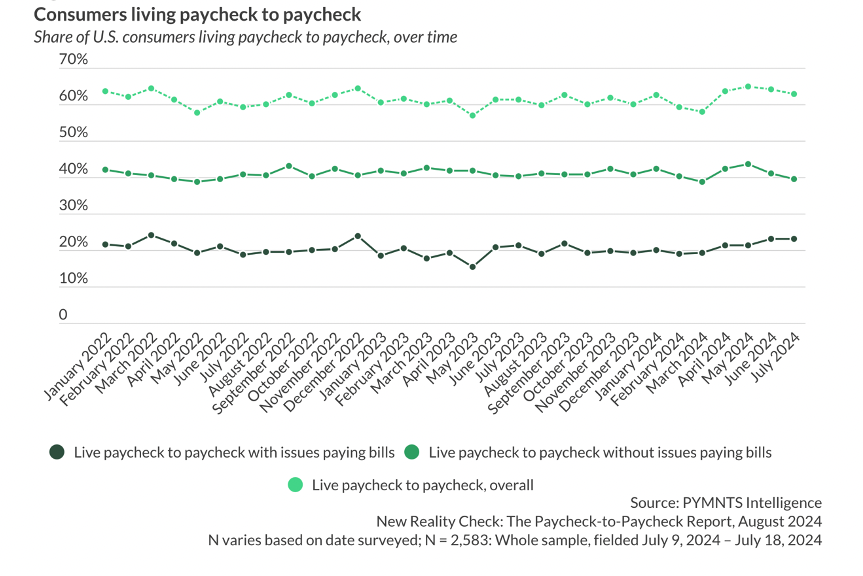
The reality is that inflation is cooling.
But perception, as they say, is reality. As captured in a PYMNTS Intelligence report in August, the reality is that the current level of essential goods and services is making it hard for paycheck-to-paycheck consumers to make ends meet.
The Consumer Price Index (CPI) rose 0.2% in July, following a 0.1% decrease in June, according to the U.S. Bureau of Labor Statistics. Over the last 12 months, the “all items” index increased 2.9%.
The food index increased 0.2% in July, with the food at home index rising 0.1%. The index for food away from home rose 0.2%. Over the last 12 months, the food index has increased 2.2%.
The shelter index accounted for nearly 90% of the all-items increase. The index rose 0.4% in July, up from 0.2% in June. Over the year, the shelter index increased 5.1%.
Other data from the July report showed a similar cooling of inflation that has been a scourge on consumer spending and the overall economy, but that doesn’t change the sum of price hikes that the paycheck-to-paycheck consumer has struggled with.
The energy index was unchanged in July after decreasing 2%. The index for gasoline was also unchanged. The index for electricity increased 0.1%, and the index for natural gas fell 0.7%.
The medical care index fell 0.2% in July, after rising 0.2% in June. The index for hospital services decreased 1.1%. The physicians’ services index and the prescription drugs index both increased by 0.1%.
The apparel index fell 0.4% in July, following a 0.1% increase in June. The index for transportation rose 0.4%, and the index for recreation rose 1.4%.
While the BLS report could lead to an interest rate cut, PYMNTS Intelligence’s “Higher Perception of Inflation Drives Paycheck-to-Paycheck Consumers to Trade Down” revealed a concerning trend. Seventy percent of consumers said their income has not kept up with inflation. This sentiment is particularly acute among paycheck-to-paycheck consumers, with 77% of those struggling to pay bills reporting their income hasn’t sufficiently offset rising costs. Even among those not living paycheck to paycheck, 61% shared this sentiment.
 According to the PYMNTS Intelligence report, most consumers said prices for food and necessities have increased in the last year. They were most likely to note the rising cost of fresh meat and produce. Prepackaged products were close behind, with 78% of consumers noting a rise in cost. This was followed by prepared foods and household goods, at 77% each.
According to the PYMNTS Intelligence report, most consumers said prices for food and necessities have increased in the last year. They were most likely to note the rising cost of fresh meat and produce. Prepackaged products were close behind, with 78% of consumers noting a rise in cost. This was followed by prepared foods and household goods, at 77% each.
Nearly three-quarters of consumers said they believe restaurant prices are on the rise. Meanwhile, 71% said they believe gas prices are still rising. These findings suggest that consumers tend to perceive rising costs for items they buy regularly, even as inflation rates have dropped in many of these areas.
This perception of income stagnation is at odds with some positive indicators in employee wages reported by the Bureau of Economic Analysis. Average hourly earnings for all employees on private nonfarm payrolls rose by 8 cents, or 0.25%, in July to $35.07. Over the past 12 months, average hourly earnings have increased nearly 3.7%.
However, PYMNTS’ data suggests that these wage increases may not be translating into a sense of financial security for many Americans. This could be due to several factors.
First, inflation has eroded the purchasing power of wage gains. Secondly, the PYMNTS survey highlighted a disparity in how different income groups experience inflation. Low-income consumers are more likely to report that their incomes have not kept up with inflation, and they report experiencing higher inflation rates for essential goods like food and housing. The disconnect between wage growth and the rising cost of living contributes to the financial strain many Americans feel. It’s forcing consumers to make difficult choices, such as cutting back on spending, trading down to cheaper products, or taking on debt.
The data from both reports underscored the complex relationship between income, inflation and consumer sentiment. While wage growth is a positive sign, it’s clear that many Americans are still struggling to keep up with the rising cost of living.
“Consumers continue to feel the financial crunch of rising prices for everything from gasoline to groceries,” the report said. “Moreover, most consumers report that their incomes have not kept up with inflation. As a result, consumers are adjusting their spending by abstaining or trading down to cheaper or lesser quality products. While this is true among all consumers, it increases as financial constraint does. Worried that inflationary pressures will continue unabated, paycheck-to-paycheck consumers continue to do what they can to make ends meet.”